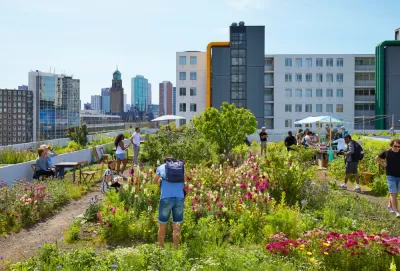What should urban planners reconsider when engaging in sustainable development?

City planners in the modern age are in one of the most exhilarating positions in history—to design projects for a sustainable future. The climate crisis is changing operations in every sector, but building projects are distinct because much of the process could shift due to global climate goals. What should urban planners reconsider when engaging in sustainable development?
Understanding the Urgency
Global temperatures will exceed sustainable levels in the coming years. Climate goals aren’t being achieved at the pace humanity needs to progress. Growing populations, industrialization, and international development require urban planning to reframe project trajectories. Planners have to construct them sustainably and assist with alleviating the climate crisis.
Dismissing the relevance of the climate crisis created vulnerable cities. Countless urban locations worldwide are susceptible to climate-influenced risks, including:
- Reduced citizen health and well-being
- Increased natural hazard severity, like drought or wildfire
- More radical temperature variances
- Inability to sustain increased population due to urban migration
Sustainable urban planning projects will create standards for future construction. Outlining precedents and priorities will simplify processes and decrease resistance against climate-focused city planning.
Preparing for Disasters
The goal is to have cities worldwide that are sturdy enough to handle generations of wear and tear—including human use and natural impact. Though sustainable urban planning intends to mitigate some of the effects of the climate crisis, the side effects of it will not dissipate immediately.
Therefore, cities must have an inherent resistance to the most intense elements humankind has ever experienced. Creating a building that can withstand hurricanes or tornadoes is a lofty goal, but it isn’t impossible.
Urban planners can consider communal infrastructure for safety and security. Making buildings safe for sheltering during natural disasters prepares citizens for the worst-case consequences of the climate crisis. It solidifies a city’s emergency management plan and ensures residents have access to clean water and air in thoughtfully constructed buildings made from sustainable yet durable materials.
It’s not just about having robust infrastructure—designing landscaping to supplement resiliency is paramount. Although trees assist in mitigating heat island effects and adverse respiratory ailments in larger cities, brittle or damaged ones with shallow roots can cause more damage during storms.
Installing Greener Cities
Keeping the climate crisis at the forefront of city planning projects is a worthwhile thesis, but how does execution look? Adaptability and independence are two overarching qualities of urban planning for the climate crisis.
Adaptive city planning will prevent flooding or high winds from damaging too much while acclimating to climate intensity and severity. It also reduces the fear of resource scarcity and provides healthier environments for residents. Finding a balance requires city planners to get creative while balancing citizens’ and sustainability needs.
A prepared city equates to a more economically viable city. Businesses seek locations for the long term—investing in a site in a climate-friendly town with healthy residents is a financial no-brainer. Areas with Internet of Things (IoT) technology to automate monitoring or that use renewable energy to cut down energy consumption and costs are more enticing.
City grids connect every infrastructure facet. For example, public transportation relies on telecommunications and energy and takes a hit if one system has an outage. Planning cities where each necessity can operate without assistance will make them more resilient and disrupt inhabitants’ lives and daily operations less frequently.
Urban Planning for a Greener Future
Some locations need restructuring from the ground up. Other cities are just beginning their development journey, but they’re blossoming from an existing environmentalist mentality. No two areas are the same for urban planners, but most places will eventually transform into embracing renewables, instilling ethical building practices and implementing technological aids for maintenance.
The future of city planning is one of the most impactful of the world’s sustainability initiatives, and its versatility and innovation will change the planet for the better.

Americans May Be Stuck — But Why?
Americans are moving a lot less than they once did, and that is a problem. While Yoni Applebaum, in his highly-publicized article Stuck, gets the reasons badly wrong, it's still important to ask: why are we moving so much less than before?

Using Old Oil and Gas Wells for Green Energy Storage
Penn State researchers have found that repurposing abandoned oil and gas wells for geothermal-assisted compressed-air energy storage can boost efficiency, reduce environmental risks, and support clean energy and job transitions.

Placekeeping: Setting a New Precedent for City Planners
How a preservation-based approach to redevelopment and urban design can prevent displacement and honor legacy communities.

Study: Maui’s Plan to Convert Vacation Rentals to Long-Term Housing Could Cause Nearly $1 Billion Economic Loss
The plan would reduce visitor accommodation by 25,% resulting in 1,900 jobs lost.

Idaho Data: Unexpected Vehicle Repairs Exacerbate Housing Instability, Eviction Risk
Over 21 percent of clients struggle with transportation barriers.

A Year-Long Investigation On Permanent Supportive Housing
The New York Times reveals what’s working and what’s not in the cornerstone of Housing First.
Urban Design for Planners 1: Software Tools
This six-course series explores essential urban design concepts using open source software and equips planners with the tools they need to participate fully in the urban design process.
Planning for Universal Design
Learn the tools for implementing Universal Design in planning regulations.
Heyer Gruel & Associates PA
City of Moreno Valley
Institute for Housing and Urban Development Studies (IHS)
City of Grandview
Harvard GSD Executive Education
Salt Lake City
NYU Wagner Graduate School of Public Service
City of Cambridge, Maryland



























